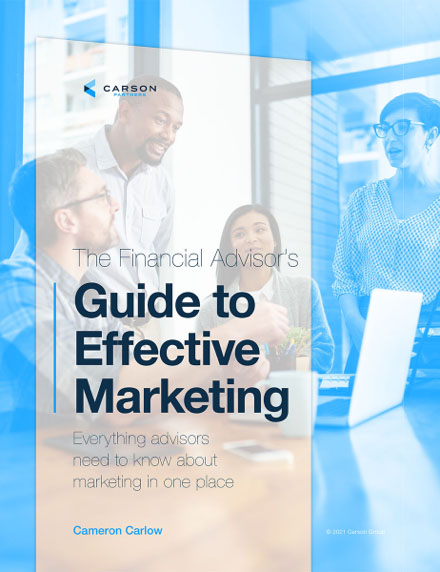Now is the time to engage in digital marketing for financial advisors. In fact, it’s no longer an “optional” activity; whether or not you are participating online, your target audience and potential clients are there, conducting online research to find a financial advisor.
The goal of digital marketing is to develop a strategy that ensures you’re in the right place at the right time with the right content. You want to show up in an authentic, polished way for those clients who are looking for someone just like you.
A recent study found that 63% of advisors are actively seeking new clients, yet only 43% have seen increases in inbound prospect requests. The strength of your digital presence can be the difference between whether you get that call and land the client – or not.
The good news is that digital marketing for financial advisors doesn’t have to be a full-time job or completely overwhelming. In fact, when you try to be all things to all people, you tend to spread yourself too thin, which limits your impact. Here are some suggestions for some of the most optimal places and ways to show up online. Decide which ones resonate with you and take the plunge.
1. A Converting Website
Having a sharp and sticky website should be your first priority because that’s where potential clients are going to search for you. You’ll want to make sure it’s mobile-friendly and populated with valuable, keyword-optimized content.
Only 61% of advisors felt their websites were effective, with 31% saying they intend to spend more on their website in 2023. For some, like Carson Partners, you’re ahead of the game because you receive a highly optimized website through a partner or third-party provider.
If you’re managing your own website, there are services like Squarespace and Wix that can help you build a website with drag-and-drop tools. However, this is one area where it is wise to engage a professional if it’s not a skill set you or a staff member feels comfortable with. A local marketing agency can help you create something professional and attention-getting, while also optimizing for your local demographic.
2. Lead Capture
Once a visitor hits your website, what then? You need to identify points during the website journey where you can offer something of value in exchange for their contact information.
Look through your site to find natural conversion points. For example, if they’ve been reading a blog post about 401(k) plans, your site can deploy a popup that asks whether they’d like to download a more complete resource, like an ebook or video. In exchange for your educational content, they’ll provide personal data you can then use to build on that relationship by engaging them via a call and an email nurture campaign.
3. Search Engine Optimization (SEO)
SEO has come a long way from the early days. If you wanted to rank for “financial advisor in (your city),” you’d just repeat that term everywhere you could on your site, in a practice known as “keyword stuffing.” But search engines like Google have become far more sophisticated and no longer fall for those tricks, which allows you to create a more engaging website.
Today, search engines index and grab data points from both your website and the person who is searching. Because data gathering is so much more refined, each web user’s history is taken into account, which means two people won’t get the same results despite making a similar inquiry. Because Google wants to deliver the top, most helpful research results for each searcher, the search engine will include a variety of nuances that yield different results.
That’s good news for you, too; you want to showcase your expertise and what makes you relevant to your target audience, rather than putting up generic content that doesn’t appeal to anyone specific and attracts an audience that isn’t likely to convert.
So what should you optimize for? Think about keyword groupings that will help you reach your ideal client. For example, maybe you have a strong background in environmental impact investing, work with small business owners or have a number of clients whom you help with real estate investing or estate planning. Think about the right kind of content that will help you rank for those terms to reach your target audience.
And remember, it’s not just text that impacts how you rank in search results. Google only indexes websites that are mobile-friendly and operate quickly. People are also searching via voice or by image, so make sure you use natural language and upload files with descriptive file names and alternative text, which also makes your site accessible to those with disabilities.
4. A System for Content Production
Who has time to write everything from articles to social media posts? It sounds daunting, but you’ll be surprised how easy it is when you use what I call the “content goldmine approach.”
First, you choose a topic where you’re highly experienced – whether it’s tax planning or saving for college – and create a detailed resource, such as an ebook, long-form video, webinar, etc. This marquee piece will become a lead magnet on your website that people will trade their contact information for. After you’ve created that piece, you’ll break it up into multiple smaller pieces.
For example, a 10-chapter guide on getting started with investing can become 10 different blog posts. Then each blog post can become four social posts as you extract statistics, quotes, etc. Once you get started, it will become second nature to see all the possibilities in each piece of content.
5. Social Media
As social media platforms continue to proliferate, it can be hard to decide where to concentrate your efforts. But you don’t have to blanket them all; instead, think about where your favorite types of clients are likely congregating online.
Young professionals might be on LinkedIn or Twitter, while an older demographic is keeping up with their grandkids on Facebook. Start with one platform and then gradually build out as your time and interest level allow.
I like to think of posting cadence like a pyramid. Your foundational content will be information-packed – think market updates, commentary and blog posts from your website. You’ll build on that base two or three times a week.
From there, once or twice a week you can post firm-related items, such as company events or employee news, to add some color and personalization to your social profile and showcase your firm’s diversity or unique culture.
Next, you’ll roll out something that entails original “thought leadership,” typically once a week or even twice per month. It doesn’t have to be long, but it should be a thoughtful take on a specific topic, something like “Three questions to ask yourself about what you want out of retirement” or “Five tax strategies to kick off 2023.” These posts are designed to be thought-provoking and ideally spur interaction. If you’re not into writing, you can film a short video, turn it into a podcast segment or create an infographic or other visual.
Finally, at the very top of the pyramid, are your personal snippets that you post when the opportunity arises and you have something worthy of sharing. Maybe you’re feeling accomplished because you finished a marathon, or maybe you’re proud of your daughter’s soccer team that finally won its last game after overcoming adversity with a difficult start. You can even share the mental health benefits you derived from becoming completely unplugged during a family vacation.
That pyramid creates the “you” part of social media, but you want to make sure your engagement isn’t only one-sided. Set aside 10 minutes of each workday to scroll through your timeline and like, comment and share relevant content you see. Social media is cyclical – you engage and they’ll engage, so take the time to be the social media follower they’ll want to follow back.
6. Digital Ads
While social media posts can be a great way to engage authentically with your clients, sometimes you need to augment it with a paid strategy to expand your reach. Digital advertising has become far more targeted, given the sophisticated tools that digital platforms have to ensure you’re reaching the right users.
They can help you target by geography, demographics, interests and more to ensure your posts are being shown only to consumers who fit your ideal client profile. If you operate within a niche, digital ads can help you reach potential clients with specific job titles, industries, age, education and more.
You can use retargeting ads to stay in front of visitors to your website, or even a specific page on your site. For example, if you noticed an estate planning blog on your site has been getting higher traffic than usual, you could use retargeting to offer those readers a gated estate planning guide to capture their contact information. You already know they are interested in that topic, and potentially need help with estate planning.
Digital advertising also helps your marketing dollars go further because you only pay when a user specifically clicks on your ad. Each platform, from Google to Facebook, works a little differently, but typically you’ll set a budget so you aren’t inadvertently hit with a huge bill if more clicks than you expected pour in. Each platform has tutorials that will help you manage your campaign and track your results.
7. Newsletter
Does a newsletter sound old-school? It’s actually a great way to stay top of mind with clients and prospects. Many advisors choose to create a newsletter that’s a compilation of other content they’ve used throughout the month, such as a digest of your blog posts, an update on office news and a short section about the market or community news.
A newsletter can be a great place to show some personality and let your brand shine. For example, I worked with an advisor who got most of their clients from equestrian shows. Once they realized this was a defined but lucrative segment, they rebranded their practice to emphasize their expertise in working with high net worth clients who all happen to be part of the horse community.
That gave them an opportunity to really focus their content on that audience. They could talk about results from recent jumping events and share pictures of horses and other updates specific to the equestrian community. It solidified who they were as a brand and served to attract more of those clients. You can do the same with any niche segment you serve, from impact investing to sports fishermen to wine connoisseurs.
To automate your email functions, use a simple tool like Campaign Monitor that allows readers to opt in to your newsletter. Automate a short series of emails that give your audience some background on who you are and how you serve your clients. Just make sure what you send is high-value and relevant to the recipient.
Digital Marketing for Financial Advisors Can Revolutionize Your Practice
Are you ready to level up your marketing strategy? With a little practice, you’ll find that mastering digital marketing for financial advisors is fulfilling and beneficial to your firm. Experiment using a mix of channels to see where you’re having the most success in attracting and engaging your ideal customers.
With a robust strategy of digital marketing for financial advisors, your practice can attract more clients and showcase your authentic self.



